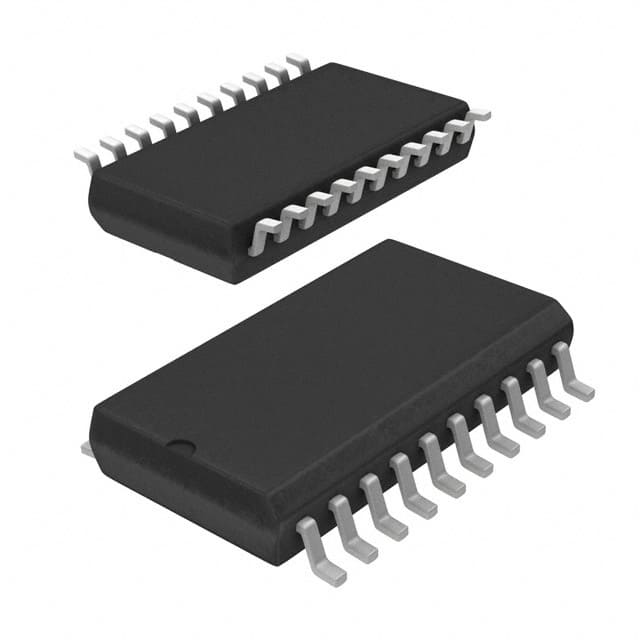TRSF3222EIDW
Basic Information Overview
- Category: Integrated Circuit (IC)
- Use: Serial Transceiver
- Characteristics:
- High-speed communication
- Low power consumption
- Small form factor
- Robust design for industrial applications
- Package: SOIC (Small Outline Integrated Circuit)
- Essence: Facilitates serial communication between devices
- Packaging/Quantity: Available in reels, typically 2500 units per reel
Specifications
- Supply Voltage: 3.3V
- Data Rate: Up to 3.4 Mbps
- Number of Channels: 2
- Operating Temperature Range: -40°C to +85°C
- Input/Output Logic Levels: CMOS/TTL compatible
Detailed Pin Configuration
- VCC - Power supply voltage
- GND - Ground
- RIN1 - Receiver input channel 1
- ROUT1 - Receiver output channel 1
- CTS1 - Clear to Send input channel 1
- RTS1 - Request to Send output channel 1
- RIN2 - Receiver input channel 2
- ROUT2 - Receiver output channel 2
- CTS2 - Clear to Send input channel 2
- RTS2 - Request to Send output channel 2
- NC - No connection
- NC - No connection
- TXD1 - Transmitter output channel 1
- RXD1 - Receiver input channel 1
- TXD2 - Transmitter output channel 2
- RXD2 - Receiver input channel 2
Functional Features
- Dual-channel transceiver for simultaneous bidirectional communication
- Supports full-duplex communication
- Auto-flow control using CTS and RTS signals
- Built-in protection features against electrostatic discharge (ESD)
- Wide operating temperature range for industrial applications
Advantages
- High-speed data transmission
- Low power consumption
- Compact size for space-constrained designs
- Reliable performance in harsh environments
- Easy integration into existing systems
Disadvantages
- Limited number of channels (2)
- Requires external components for voltage level translation
- Not suitable for high-voltage applications
Working Principles
The TRSF3222EIDW is a dual-channel serial transceiver that enables bidirectional communication between devices. It operates by converting parallel data into serial data for transmission and vice versa. The transceiver uses CMOS/TTL logic levels for compatibility with various microcontrollers and other devices. It incorporates auto-flow control using CTS and RTS signals to prevent data overflow or loss. The device also includes protection features against electrostatic discharge, ensuring reliable operation in industrial environments.
Detailed Application Field Plans
The TRSF3222EIDW finds applications in various fields, including: 1. Industrial Automation: Used for communication between PLCs (Programmable Logic Controllers), sensors, and actuators. 2. Telecommunications: Enables data transmission between network equipment, such as routers and switches. 3. Automotive Electronics: Facilitates communication between different electronic modules within vehicles. 4. Medical Devices: Allows for data exchange between medical instruments and control systems. 5. Consumer Electronics: Used in devices like gaming consoles, set-top boxes, and home automation systems.
Detailed and Complete Alternative Models
- MAX3222 - Similar dual-channel transceiver with comparable specifications.
- SN65HVD22 - Dual-channel transceiver designed for industrial applications.
- LTC2872 - High-speed dual-channel transceiver with extended temperature range.
(Note: This list is not exhaustive and there are several other alternative models available in the market.)
This entry provides an overview of the TRSF3222EIDW serial transceiver, including its basic information, specifications, pin configuration, functional features, advantages, disadvantages, working principles, application field plans, and alternative models. The TRSF3222EIDW is a versatile IC that enables reliable and high-speed communication between devices in various industries.
Senaraikan 10 soalan dan jawapan biasa yang berkaitan dengan aplikasi TRSF3222EIDW dalam penyelesaian teknikal
Sure! Here are 10 common questions and answers related to the application of TRSF3222EIDW in technical solutions:
Q: What is TRSF3222EIDW? A: TRSF3222EIDW is a dual-channel RS-232 transceiver IC (Integrated Circuit) used for serial communication in various technical applications.
Q: What is the operating voltage range of TRSF3222EIDW? A: The operating voltage range of TRSF3222EIDW is typically between 3.0V and 5.5V.
Q: Can TRSF3222EIDW be used for both transmitting and receiving data? A: Yes, TRSF3222EIDW can be used for both transmitting and receiving data over RS-232 interface.
Q: What is the maximum data rate supported by TRSF3222EIDW? A: TRSF3222EIDW supports a maximum data rate of 1 Mbps (megabits per second).
Q: Does TRSF3222EIDW have built-in ESD protection? A: Yes, TRSF3222EIDW has built-in ESD (Electrostatic Discharge) protection, which helps protect the IC from damage due to static electricity.
Q: Can TRSF3222EIDW be used in industrial applications? A: Yes, TRSF3222EIDW is suitable for use in industrial applications as it can operate in harsh environments and has robust features.
Q: Is TRSF3222EIDW compatible with different microcontrollers and processors? A: Yes, TRSF3222EIDW is compatible with a wide range of microcontrollers and processors that support RS-232 communication.
Q: Can TRSF3222EIDW be used in battery-powered devices? A: Yes, TRSF3222EIDW can be used in battery-powered devices as it operates at low power and has a wide operating voltage range.
Q: Does TRSF3222EIDW support flow control signals? A: Yes, TRSF3222EIDW supports hardware flow control signals such as RTS (Request to Send) and CTS (Clear to Send).
Q: Are there any application notes or reference designs available for TRSF3222EIDW? A: Yes, Texas Instruments provides application notes and reference designs that can help in implementing TRSF3222EIDW in various technical solutions.
Please note that the answers provided here are general and may vary depending on specific requirements and use cases. It is always recommended to refer to the datasheet and documentation provided by the manufacturer for accurate information.


